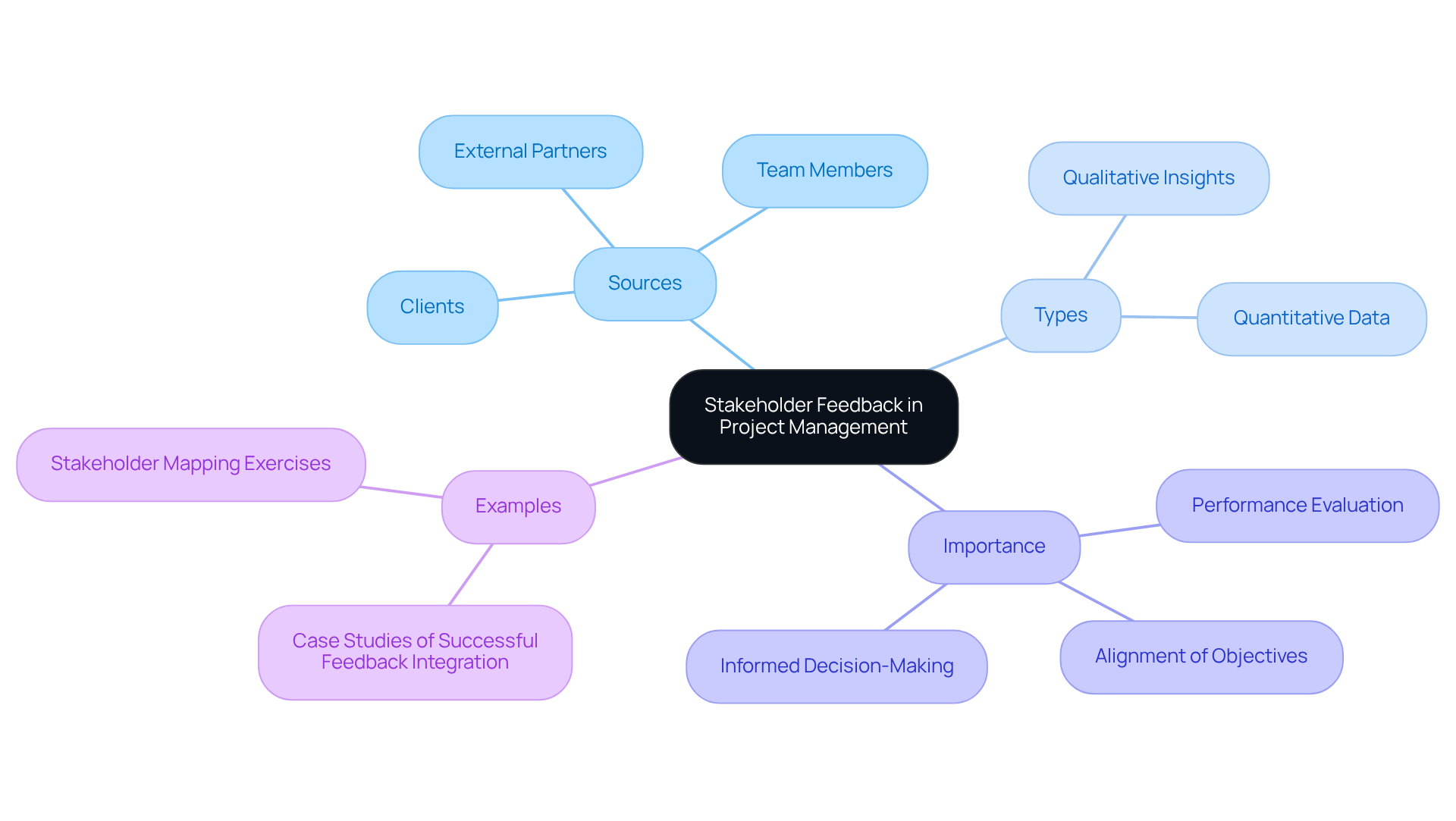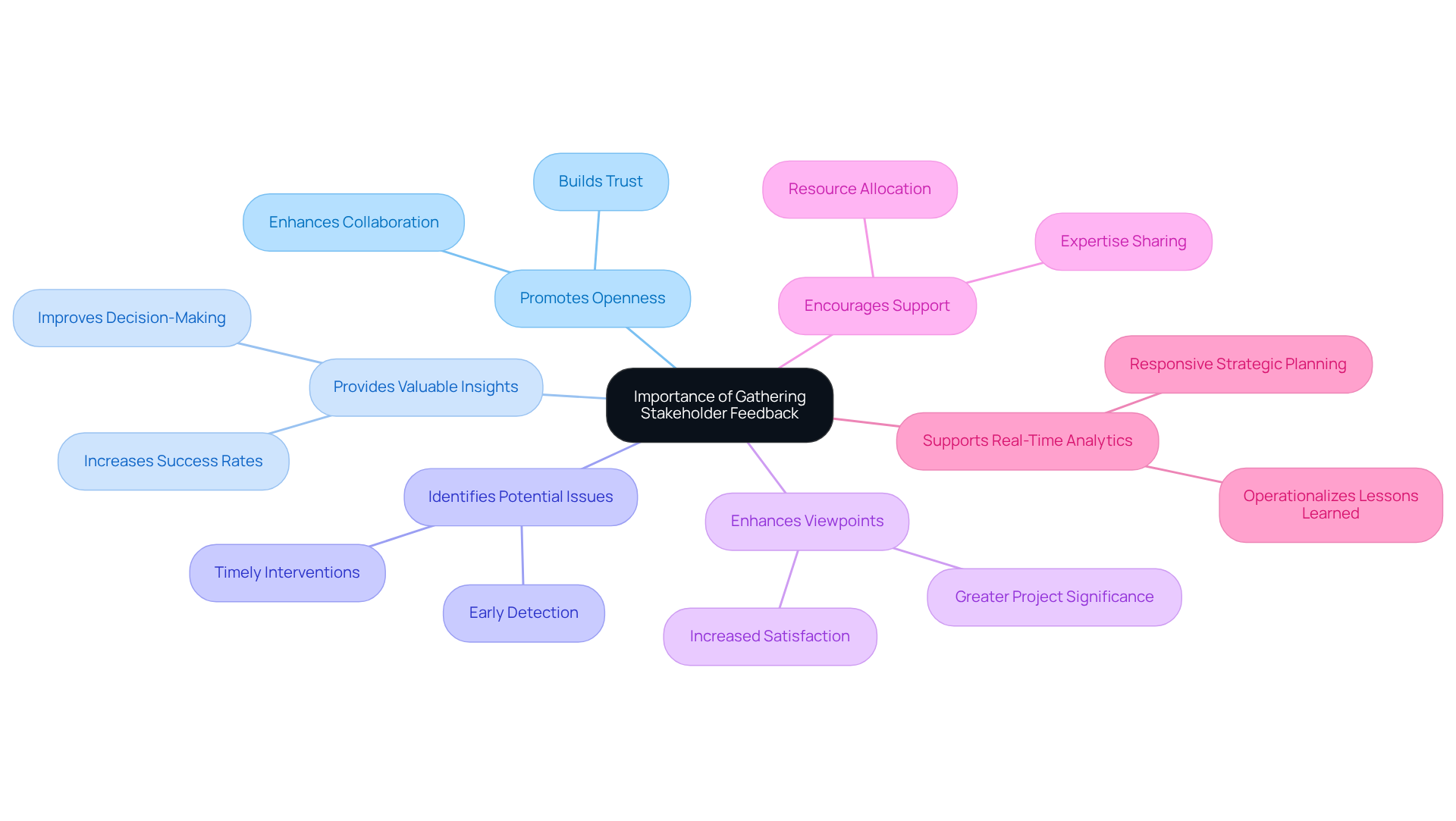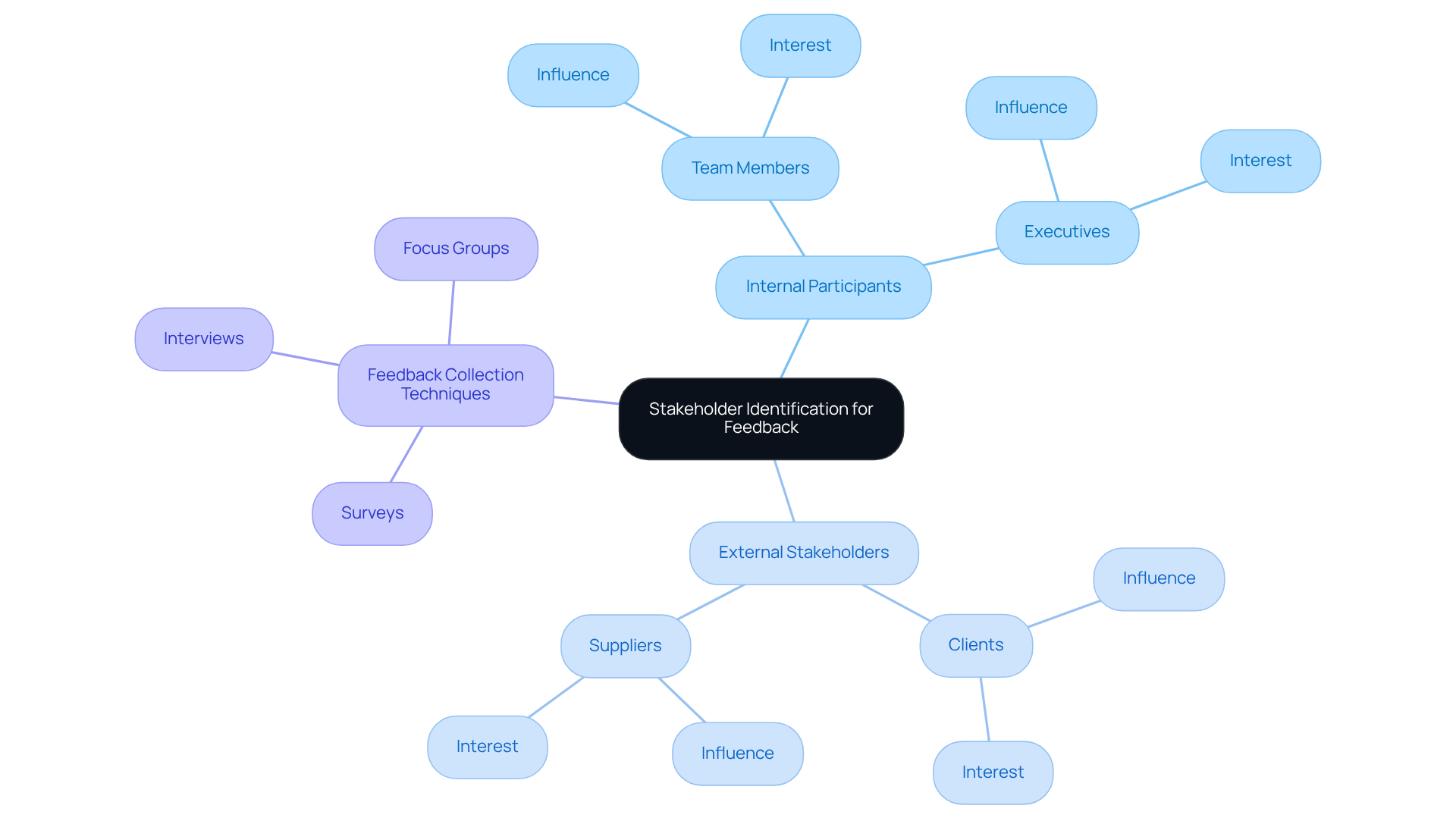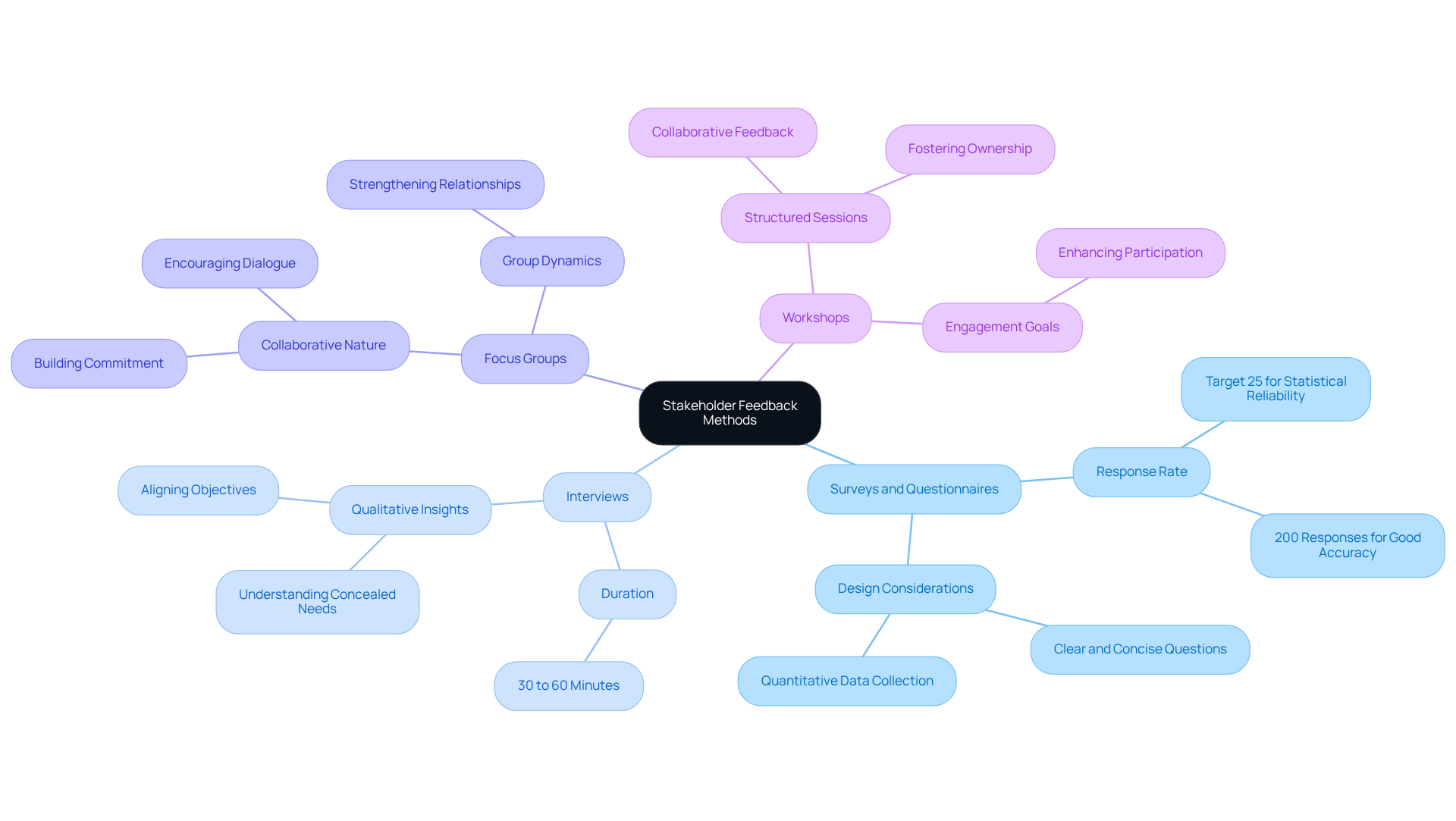Overview
The primary focus of this article is the essential steps necessary for effectively gathering stakeholder feedback within project management. It presents a structured approach that encompasses:
- The identification of stakeholders
- The application of diverse methods for collecting feedback
- The analysis of the input received
- The implementation of changes based on that feedback
This process ultimately enhances project outcomes and fosters greater stakeholder engagement.
Introduction
Gathering stakeholder feedback stands as a cornerstone of successful project management; however, many managers overlook its profound impact on project outcomes. This article explores the essential steps for effectively collecting and implementing feedback from stakeholders, providing valuable insights that can significantly enhance collaboration and decision-making. The challenge, nonetheless, lies in navigating the diverse perspectives and expectations of various stakeholders. How can managers ensure that every voice is heard and that feedback translates into actionable improvements?
Define Stakeholder Feedback in Project Management
Stakeholder feedback project management includes evaluative information, opinions, and suggestions from individuals or groups involved in an initiative. This input can originate from various sources, including clients, team members, and external partners, rendering it a crucial element for managers. It serves as a vital component for evaluating performance, aligning objectives, and facilitating informed decision-making. In the context of a comprehensive business evaluation, input from interested parties plays a pivotal role in understanding the business landscape beyond mere figures. This enables managers to identify fundamental issues and enhance essential advantages.
Understanding the nuances of feedback—ranging from qualitative insights gathered through interviews to quantitative data collected from surveys—is essential for effective management. Moreover, incorporating stakeholder feedback in project management into the decision-making process can streamline operations and improve performance monitoring, ultimately leading to superior outcomes. For instance, a manager who actively sought input from stakeholders during a significant transformation effort was able to enhance executive understanding and support. This illustrates how contributions from engaged individuals foster cooperation and commitment among all parties involved.

Understand the Importance of Gathering Stakeholder Feedback
Collecting stakeholder feedback for project management is crucial for various reasons.
- It promotes openness and confidence among teams and stakeholders, which is essential for effective stakeholder feedback project management and enhances collaboration. This aligns with the comprehensive business review process, where stakeholder feedback project management is essential for understanding the perspectives of involved parties, identifying underlying issues, and reinforcing strengths.
- It offers valuable insights that can enhance stakeholder feedback project management, leading to improved decision-making and results. Studies indicate that initiatives with significant levels of participant involvement are 40% more likely to succeed compared to those with limited involvement.
- By actively seeking stakeholder feedback in project management, managers can identify potential issues early, allowing for timely interventions.
- Moreover, stakeholder feedback in project management can enhance the viewpoints of involved parties, leading to greater project significance and satisfaction, ultimately resulting in greater success.
- Involved parties are more likely to provide support, resources, and expertise, revealing new opportunities and improving processes.
- This ongoing exchange of information supports real-time analytics and operationalizes lessons learned, ensuring that strategic planning is responsive and effective.

Identify Your Stakeholders for Effective Feedback
To effectively collect valuable stakeholder feedback for project management, managers must first identify their interested parties. This includes both internal participants, such as team members and executives, as well as external stakeholders like clients and suppliers. By employing mapping techniques, such as power-interest grids, managers can categorize involved parties based on their influence and interest in the project. This strategic approach to stakeholder feedback project management assists in prioritizing whom to involve for input, ensuring that the most relevant voices are heard.
Moreover, recent insights underscore the necessity of stakeholder feedback project management by engaging parties according to their influence and interest to secure support and commitment. Furthermore, utilizing diverse techniques for gathering responses—such as surveys and interviews—can significantly enhance the quality of insights obtained. It is equally essential to involve nontechnical groups to ensure a comprehensive understanding of the dynamics at play.
Consequently, by systematically charting involved parties and employing varied input collection methods, project leaders can foster improved teamwork and decision-making, ultimately propelling project success.

Collect Stakeholder Feedback Using Structured Methods
To effectively gather input from interested parties, employing structured methods in stakeholder feedback project management is essential. Here are several common techniques that can significantly enhance your project outcomes:
-
Surveys and Questionnaires: Craft concise surveys with clear, unambiguous questions to gather quantitative data. Aim for a response rate of at least 25% to ensure statistical reliability, targeting around 200 responses for good accuracy. Notably, a population of 1000 with a 25% response rate yields approximately 95% certainty of +/-5% accuracy, providing a solid benchmark for survey effectiveness.
-
Interviews: Conduct one-on-one interviews lasting 30 to 60 minutes to gain in-depth qualitative insights. This approach is especially efficient for revealing concealed needs and harmonizing objectives, ensuring that the perspectives of involved parties are comprehensively understood.
-
Focus Groups: Arrange group conversations that motivate participants to express their views and promote dialogue. This collaborative approach can enhance commitment to project success and strengthen relationships among participants.
-
Workshops: Facilitate structured sessions where participants can provide feedback in a collaborative environment. Workshops not only gather insights but also build relationships among participants, fostering a sense of ownership and engagement.
Choosing the suitable approach according to your context and participant preferences is vital for enhancing involvement and response rates. Consistently requesting stakeholder feedback in project management through these organized approaches can greatly enhance project results and participant satisfaction.

Analyze and Implement Stakeholder Feedback Effectively
After gathering stakeholder feedback for project management, the next crucial step is a systematic analysis. Begin by organizing responses into distinct themes or issues; this aids in recognizing patterns and prioritizing areas for action. Employ analytical tools such as the Stakeholder Quote Analysis Tool, SWOT analysis, or feedback matrices to assess the significance of each piece of feedback. This structured approach not only clarifies insights but also supports decision-making in stakeholder feedback project management. As Changefirst highlights, involving interested parties through stakeholder feedback in project management in a consistent and structured manner enhances success.
Incorporating real-time business analytics into this process can significantly boost the effectiveness of your analysis. By utilizing a client dashboard that provides continuous performance monitoring, you can swiftly diagnose business health and make informed decisions, thereby supporting a shortened decision-making cycle. Once the analysis is complete, it is essential to communicate the findings back to interested parties involved in the stakeholder feedback project management. This transparency illustrates how stakeholder feedback in project management will directly influence decisions, fostering trust and engagement. Implement necessary changes based on stakeholder feedback project management, and establish a continuous feedback loop to keep interested parties informed about the outcomes of their contributions. This iterative process not only enhances project alignment with stakeholder expectations but also cultivates a culture of collaboration and responsiveness within the organization.
Conclusion
Gathering stakeholder feedback transcends mere procedural tasks in project management; it stands as a fundamental practice that propels project success and nurtures collaboration. By actively engaging with stakeholders and integrating their insights, managers can forge a more inclusive environment that not only enhances decision-making but also aligns project objectives with the expectations of all involved parties.
Throughout the discussion, the significance of stakeholder feedback has been underscored, illustrating its role in promoting transparency, identifying potential issues early, and enhancing project outcomes. Techniques such as:
- Surveys
- Interviews
- Focus groups
emerge as effective methods for collecting diverse perspectives. Moreover, the systematic analysis of feedback guarantees that insights are actionable and that stakeholders remain informed about how their contributions shape project direction.
In conclusion, the process of gathering and implementing stakeholder feedback should be regarded as an ongoing commitment rather than a one-time endeavor. By cultivating a culture of open communication and responsiveness, project managers can not only enhance project alignment with stakeholder expectations but also foster a collaborative atmosphere that drives innovation and success. Embracing these practices will ultimately lead to more successful projects and stronger relationships with stakeholders, making it imperative for managers to prioritize this critical aspect of project management.
Frequently Asked Questions
What is stakeholder feedback in project management?
Stakeholder feedback in project management refers to evaluative information, opinions, and suggestions from individuals or groups involved in a project. This feedback can come from clients, team members, and external partners, and is crucial for evaluating performance, aligning objectives, and facilitating informed decision-making.
Why is gathering stakeholder feedback important?
Gathering stakeholder feedback is important because it promotes openness and confidence among teams and stakeholders, enhances collaboration, provides valuable insights for decision-making, and helps identify potential issues early. Projects that involve significant stakeholder participation are more likely to succeed.
How does stakeholder feedback contribute to project management success?
Stakeholder feedback contributes to project management success by enhancing the understanding of involved parties' perspectives, reinforcing strengths, and revealing new opportunities. It leads to greater project significance and satisfaction, ultimately resulting in improved outcomes.
What types of feedback are considered stakeholder feedback?
Stakeholder feedback can include qualitative insights gathered through interviews and quantitative data collected from surveys, providing a comprehensive view of project performance and stakeholder perspectives.
How can managers effectively incorporate stakeholder feedback?
Managers can effectively incorporate stakeholder feedback by actively seeking input from stakeholders throughout the project, which can streamline operations, improve performance monitoring, and foster cooperation and commitment among all involved parties.
What role does stakeholder feedback play in decision-making?
Stakeholder feedback plays a critical role in decision-making by providing insights that inform strategies, allowing for timely interventions, and ensuring that strategic planning is responsive to the needs and concerns of all parties involved.




